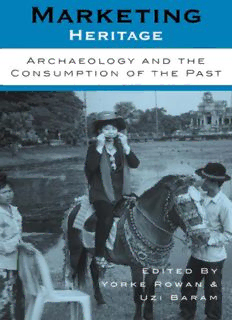
Marketing Heritage: Archaeology and the Consumption of the Past PDF
Preview Marketing Heritage: Archaeology and the Consumption of the Past
MARKETING HERITAGE MARKETING HERITAGE Archaeology and the Consumption of the Past c EDITED BY YORKE ROWAN & UZI BARAM ALTAMIRA PRESS A Division ofRowman & Littlefield Publishers, Inc. Walnut Creek•Lanham•New York•Toronto•Oxford ALTAMIRAPRESS A division of Rowman & Littlefield Publishers, Inc. 1630 North Main Street, #367 Walnut Creek, California 94596 www.altamirapress.com Rowman & Littlefield Publishers, Inc. A wholly owned subsidiary ofThe Rowman & Littlefield Publishing Group, Inc. 4501 Forbes Boulevard, Suite 200 Lanham, Maryland 20706 PO Box 317 Oxford OX2 9RU, UK Copyright © 2004 by ALTAMIRAPRESS “Deep Dirt: Messing Up the Past at Colonial Williamsburg” reprinted with permission of Berghahn Books. All rights reserved. No part of this publication may be reproduced, stored in a retrieval system, or transmitted in any form or by any means, electronic, mechanical, photocopying, recording, or otherwise, without the prior permission of the publisher. British Library Cataloguing in Publication Information Available Library of Congress Cataloging-in-Publication Data Marketing heritage : archaeology and the consumption of the past / edited by Yorke Rowan and Uzi Baram. p. cm. Includes bibliographical references and index. ISBN 0-7591-0341-0 (hardcover : alk.paper) — ISBN 0-7591-0342-9 (pbk. : alk. paper) 1. Cultural property—Protection. 2. Heritage tourism. 3. Excavations (Archaeology)—Interpretive programs. 4. Archaeology—Economic aspects. 5. Historic preservation. I. Rowan, Yorke M. II. Baram, Uzi, 1964– CC135.M325 2004 338.4'791—dc22 2003018553 Printed in the United States of America ∞ ™ The paper used in this publication meets the minimum requirements of American National Standard for Information Sciences—Permanence of Paper for Printed Library Materials, ANSI/NISO Z39.48-1992. CONTENTS c Preface ix Part I: Introduction CHAPTER 1 Archaeology after Nationalism: Globalization and the Consumption of the Past UZI BARAM AND YORKE ROWAN 3 Part II: The Legal and Historical Context for Marketing Heritage CHAPTER 2 International Conventions and Cultural Heritage Protection BONNIE MAGNESS-GARDINER 27 CHAPTER 3 The Politics of Playing Fair, or, Who’s Losing Their Marbles? MORAG KERSEL 41 CHAPTER 4 From Lord Elgin to James Henry Breasted: The Politics of the Past in the First Era of Globalization STEVE VINSON 57 v vi CONTENTS Part III: The Past as Commodity CHAPTER 5 Conflating Past and Present: Marketing Archaeological Heritage Sites in Ireland KELLI ANN COSTA 69 CHAPTER 6 Mementos of the Past: Material Culture ofTourism at Stonehenge and Avebury AMY GAZIN-SCHWARTZ 93 CHAPTER 7 Where Are the Maya in Ancient Maya Archaeological Tourism? Advertising and the Appropriation of Culture TRACI ARDREN 103 Part IV: Archaeology in the Global Age CHAPTER 8 Archaeological Research and Cultural Heritage Management in Cambodia’s Mekong Delta: The Search for the “Cradle of Khmer Civilization” MIRIAM T. STARK AND P. BION GRIFFIN 117 CHAPTER 9 Recovering the German Nation: Heritage Restoration and the Search for Unity JASON JAMES 143 CHAPTER 10 Deep Dirt: Messing Up the Past at Colonial Williamsburg ERIC GABLE AND RICHARD HANDLER 167 CHAPTER 11 Targeting Heritage: The Abuse of Symbolic Sites in Modern Conflicts JONATHAN GOLDEN 183 Part V: Representing the Past CHAPTER 12 Tourism, the Ideology of Design, and the Nationalized Past in Zippori/Sepphoris, an Israeli National Park JOEL BAUMAN 205 CONTENTS vii CHAPTER 13 The Roads to Ruins: Accessing Islamic Heritage in Jordan ERIN ADDISON 229 CHAPTER 14 Repackaging the Pilgrimage: Visiting the Holy Land in Orlando YORKE ROWAN 249 Part VI: Archaeologists and the Marketing of Heritage CHAPTER 15 Is the Medium the Message? The Art of Interpreting Archaeology in U.S. National Parks BARBARA J. LITTLE 269 CHAPTER 16 Engaging with Heritage Issues: The Role of the World Archaeological Congress JOAN M. GERO 287 CHAPTER 17 Making the Past Profitable in an Age of Globalization and National Ownership: Contradictions and Considerations PHILIP L. KOHL 295 Index 303 About the Contributors 311 Preface c EIGHTEENKILOMETERSWESTof the Israeli Negev city of Beersheva lies the Chalcolithic site of Shiqmim. Excavated by Thomas E. Levy and the late David Alon from 1979 to 1993, the site provides a fantastic view of Chal- colithic (4500–3500 B.C.E.) life along the Wadi Beersheva. Underground tunnels, house foundations, human burials, copper artifacts, ivory ornaments, and a wealth of other items have been uncovered. Levy has argued persuasively for a model of chiefdom for this place and its time period. One cannot visit Shiqmim easily. The site is in a restricted military zone and is far from any roads. However, the Israel Museum in Jerusalem displays some of its artifacts. Numerous publications discuss the site, excavations, and cultural his- tory. A web page based at the Department of Anthropology of University of Cal- ifornia, San Diego, is an accessible means of learning about and seeing the site. Shiqmim is an important archaeological site; the architecture and artifacts are en- gaging; the desert is simply beautiful. We both excavated at Shiqmim. Coincidentally, so did three other contribu- tors to this volume (Morag Kersel, Jonathan Golden, and Joel Bauman). We both use Shiqmim in our teaching. Shiqmim provides wonderful stories for teaching un- dergraduate anthropology—the dramatic landscape, the hardships of excavating far from electricity, water, and information outlets. And the rich array of material culture offers adventure, science, and a portal to the past. When either of us is asked about our most interesting excavations, as happens often to archaeologists, Shiqmim is usually the story told. Yet there is no marketing of Shiqmim for tourists by the state of Israel. Based on our experiences at Shiqmim, and with a contrast to the nearby ac- tively promoted sites like Masada and Petra in mind, we wrestled with how ancient ix
Description: